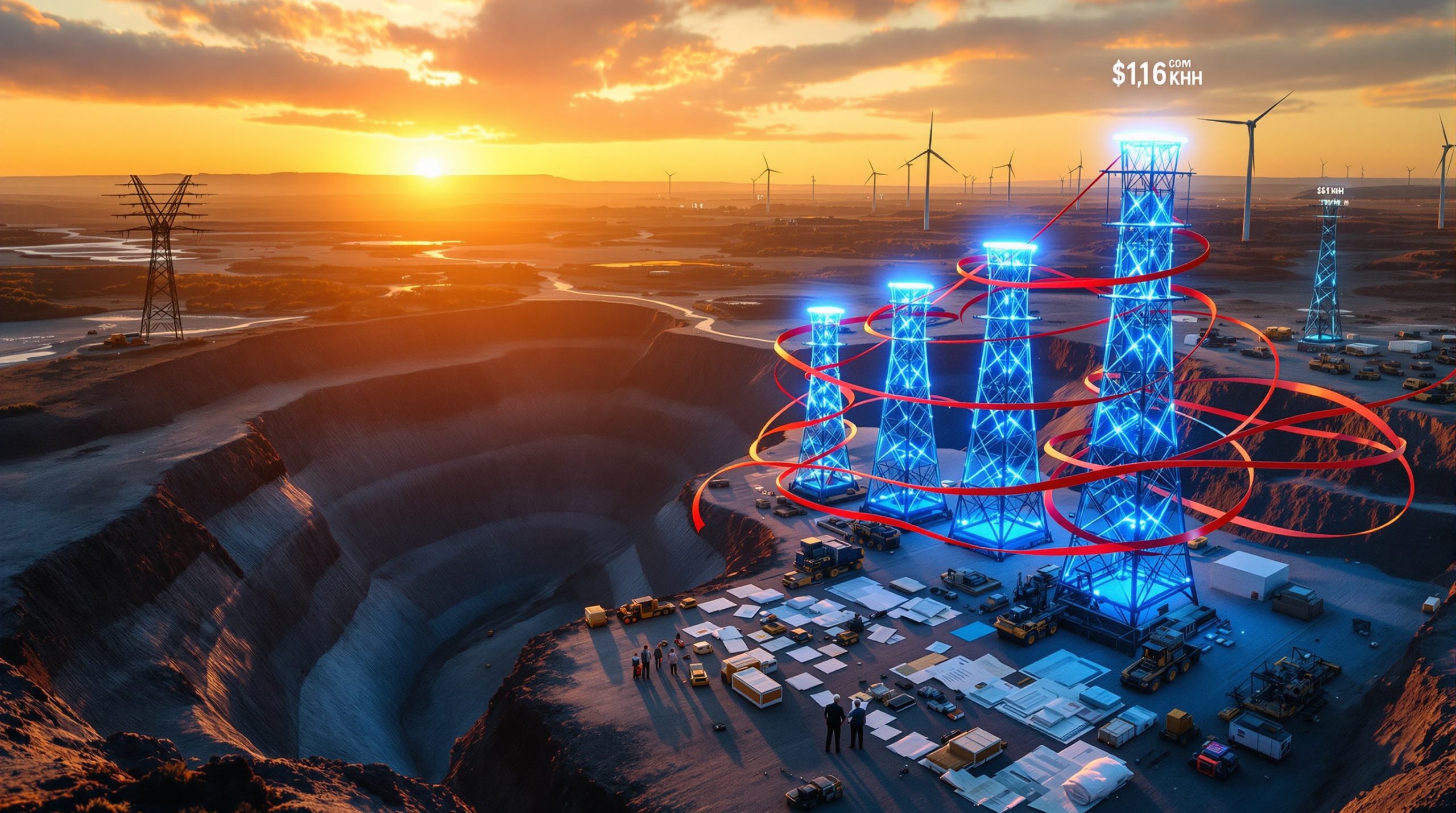The Strategic Convergence of AI and Nuclear Power
The United States' comprehensive AI Action Plan, unveiled on July 23, 2025, represents a pivotal shift in national energy strategy, directly connecting artificial intelligence development with nuclear power expansion. This strategic realignment positions uranium as a critical resource in America's technological future, creating significant implications for domestic uranium producers and global supply chains.
According to Bruce Lane, managing director of GTI Energy Ltd (ASX:GTR, OTC:GTRIF), this development is "extremely positive and supportive" for the US uranium sector, signaling a fundamental shift in how policymakers view nuclear energy's role in technological advancement.
What Does the AI Action Plan Include?
The Trump mineral order sweeping initiative outlines over 90 policy actions across three strategic pillars:
- Accelerating AI innovation through research funding and regulatory frameworks
- Building robust American AI infrastructure with focus on energy security
- Leading international diplomacy and security efforts in the AI space
The plan builds upon executive orders issued by US President Donald Trump in May 2025 that specifically targeted nuclear energy deployment as a foundation for AI development, recognizing the enormous energy demands of advanced computing systems.
As Lane explained: "What the AI executive orders are doing is adding another layer of urgency and focus on what is already a very well understood challenge." This represents a significant shift in national energy policy, elevating nuclear power from environmental consideration to strategic necessity.
Why is Nuclear Power Critical for AI Development?
The AI Energy Challenge
AI systems, particularly large language models and data centers, require extraordinary amounts of electricity. Consider these energy requirements:
- Training sophisticated AI models demands massive computational resources
- AI data centers require continuous, uninterrupted power supply
- Renewable energy sources alone cannot meet the reliability and scale requirements
As Lane noted in his Proactive Investors interview: "We're not at that point yet where energy is free – we're still very much in that phase where energy is the bottleneck." This recognition of energy constraints has driven the renewed focus on nuclear power.
Nuclear Advantages for AI Infrastructure
Nuclear energy offers unique benefits that align perfectly with AI computing needs:
- Baseload Reliability: 24/7 power generation regardless of weather conditions
- Zero-Carbon Output: Alignment with corporate ESG commitments
- Energy Density: Small physical footprint relative to power output
- Scalability: Particularly with small modular reactor (SMR) technologies
These advantages position nuclear energy as a strategic foundation for the coming AI revolution, creating a symbiotic relationship between technological advancement and energy security.
What's Driving the US Uranium Supply Crisis?
Current Supply-Demand Imbalance
The United States faces a critical uranium market volatility challenge that threatens both energy security and technological leadership:
- Annual uranium demand: 47-50 million pounds
- Current domestic production: Approximately 1 million pounds annually
- Deficit: 46-49 million pounds imported annually
Lane emphasized this challenge: "The US is supplying only about a million pounds a year, and that number has to grow." This massive gap creates significant national security vulnerabilities, especially as AI competition with global rivals intensifies.
Historical Context of US Uranium Production
The American uranium industry has experienced decades of decline that has left the country vulnerable:
- 1980s: US was a leading global uranium producer
- 1990s-2010s: Production collapsed due to cheaper foreign imports
- 2020s: Renewed focus on domestic production but significant rebuilding required
"What we're starting to see is that the sector is getting some attention, some investment, some support from the government, after not getting much support for decades," Lane explained. This historical context explains why the current policy shift represents such a dramatic change in direction.
How Will the AI Plan Impact Uranium Markets?
Projected Uranium Demand Growth
The global uranium market faces structural deficits even before accounting for AI-driven demand:
- Goldman Sachs projects a 130 million pound global shortfall by 2040
- Nuclear's share of energy mix expected to remain at least 18-20% of growing demand
- AI data centers could accelerate demand beyond current projections
Lane highlighted this growth trajectory: "Even if nuclear maintains just 18-20% of its share of the growth, we'll see a massive increase in nuclear power — and a massive increase in requirement for uranium." This demand growth creates significant opportunities for uranium producers positioned to capture market share.
Policy Implications for Uranium Producers
The AI Action Plan creates several favorable conditions for uranium companies:
- Streamlined permitting processes for new mines
- Federal support for uranium conversion and enrichment
- Potential long-term contracts at incentive pricing
- Renewed investment interest in uranium exploration
These policy shifts could fundamentally alter the economics of uranium production in the United States, potentially unlocking billions in capital investment and thousands of high-paying jobs.
What Challenges Remain for Uranium Development?
Despite positive policy shifts, significant hurdles remain for uranium development:
Economic Challenges
- New uranium projects require long-term price commitments
- Current spot pricing remains below full incentive levels for new mine development
- Capital investment requirements remain substantial
Lane identified these challenges directly: "What the industry needs for long-term, committed supply is to be underpinned by long-term contracts at a high-enough incentive price for everyone to make some money along the way. And those conditions don't really exist for new-start projects."
Technical and Regulatory Hurdles
- Permitting timelines remain lengthy despite streamlining efforts
- Skilled workforce development needed across the nuclear supply chain
- Public perception challenges in some regions
The AI Action Plan acknowledges these challenges but recognizes that they must be overcome to achieve technological leadership in artificial intelligence.
Which Companies Stand to Benefit?
The policy shift creates opportunities across the uranium sector, with certain companies particularly well-positioned:
US-Focused Developers
Companies with advanced projects in the United States could see significant valuation increases:
- Producers with existing infrastructure can rapidly scale production
- Developers with permitted projects can accelerate timelines
- Companies with ISR (In-Situ Recovery) capabilities offer fastest path to production
GTI Energy's Lo Herma ISR Uranium Project in Wyoming's Southern Powder River Basin represents this type of opportunity, with Lane noting the company's strategic positioning in the heart of America's uranium country.
International Players with US Exposure
International uranium companies with American assets may see increased valuation:
- Australian companies with US projects benefit from both markets
- Canadian producers with US uranium disruption operations gain strategic advantage
- Companies with processing capabilities become increasingly valuable
Snow Lake Resources was highlighted in the Proactive Investors report as lauding the AI Action Plan's focus on nuclear energy for fast-tracking development timelines for their Pine Ridge project, demonstrating the impact across multiple companies.
What's the Long-Term Outlook for Nuclear and Uranium?
Structural Transformation of Energy Markets
The AI-nuclear connection represents a fundamental shift in how energy markets view uranium:
- From niche fuel to strategic resource
- From environmental concern to climate solution
- From legacy technology to AI enabler
This transformation could permanently alter uranium's position within global energy markets, creating sustained demand growth for decades.
Global Competition Dynamics
The US push creates ripple effects across global markets:
- Other major powers likely to accelerate their own nuclear development
- European nations reassessing nuclear phase-out plans
- Australia considering nuclear options after decades of prohibition
Lane summarized the situation: "There's a huge gap if the US wants to shore up its strategic position and have domestic supply of uranium and, critically, conversion and enrichment." This global competition will likely drive continued policy support and investment.
FAQ: Key Questions About AI and Nuclear Energy
How much additional uranium will AI development require?
While precise figures remain uncertain, industry analysts suggest AI could increase uranium demand by 10-15% above baseline projections by 2030, representing millions of additional pounds annually. This estimate is based on projected data center growth and energy intensity of AI model training.
Can renewable energy alone power AI development?
Renewable energy will play an important role but cannot provide the reliability, density, and scale required for advanced AI systems without massive battery storage infrastructure that presents its own resource challenges. Nuclear power offers a complementary solution that addresses these limitations.
How quickly can domestic uranium production increase?
Existing producers could potentially double output within 2-3 years, but developing new mines typically requires 5-10 years from discovery to production, even with streamlined permitting. This timeline creates urgency for policy action now to meet future demands.
What role will small modular reactors play?
SMRs offer significant advantages for AI infrastructure, including scalability, reduced capital costs, and potential for distributed deployment near data centers. Their development timeline aligns with projected AI growth curves, making them particularly well-suited for this application.
Key Takeaways: The New Uranium Landscape
The convergence of AI development and nuclear energy represents a paradigm shift for uranium markets:
- Strategic Elevation: Uranium transitions from commodity to strategic resource
- Policy Support: Government backing creates favorable investment environment
- Supply Chain Focus: Entire nuclear fuel cycle receives renewed attention
- Long-Term Demand: Structural deficit likely to persist for decades
- National Security Priority: Domestic production becomes critical objective
This transformation creates both opportunities and challenges for industry participants, investors, and policymakers as they navigate the complex intersection of technology, energy, and national security.
"What the AI executive orders are doing is adding another layer of urgency and focus on what is already a very well understood challenge." – Bruce Lane, Managing Director of GTI Energy Ltd (ASX:GTR, OTC:GTRIF)
The US AI Action Plan's nuclear push represents a watershed moment for uranium markets, creating a new paradigm where technological advancement and energy security are inseparably linked. For companies positioned to meet this demand, the opportunities could be transformative, though some producers like those affected by the Paladin uranium halt may face challenges. Meanwhile, exploration companies with promising assets like the Patterson Corridor project could see increased investor interest as the White House AI Action Plan continues to reshape the market.
Disclaimer: This article contains forward-looking statements regarding the uranium market and AI development. Actual results may differ materially from projections. Readers should conduct their own research before making investment decisions.
Looking for the Next Major Mineral Discovery?
Discover how significant ASX mineral discoveries can lead to substantial market returns by exploring Discovery Alert's dedicated discoveries page, where our proprietary Discovery IQ model transforms complex mineral data into actionable investment insights for both short-term traders and long-term investors.




